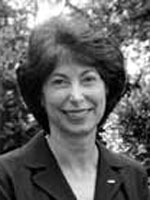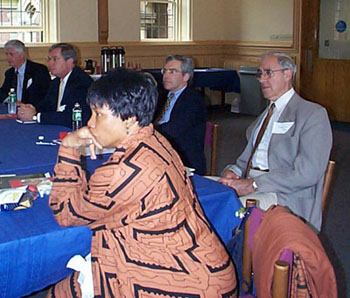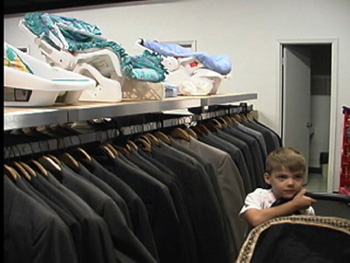When did the realities of the current economic situation become real for you? Were you tracking your assets on a regular basis or did you open your quarterly statement from your pension fund one day and need to be revived?
When did the impact of the situation on your school become real for you? Here's a bottom line: If last year's average operating debt of all ATS schools were spread evenly among members, each would be more than $600,000 in the red.
What to do? Here are three stories of schools that caught the drift fairly early on and acted quickly. Their endowments range from $8 million to $800 million; they are geographically and theologically diverse. What they have in common is a willingness to look at hard truths, a willingness to reach beyond themselves for help, and a willingness to do something different for the sake of their mission. What is your school doing?
Princeton Theological Seminary
"I don't expect sympathy," said Thomas Gillespie, president of Princeton Theological Seminary, about the roller coaster ride of the New Jersey school's endowment fund from $350 million in 1990 to a high just $85 million shy of a billion, then down to $686 million in 2000 and now back above the $700 million mark. "But remember, everything's relative. The problem with a big endowment is that you live by it."
Princeton lives by its endowment to the tune of 80 percent of its operating budget, and that has meant, in Gillespie's words, "being able to do what we want to do." That includes giving out $5 million a year in scholarship money. A new day has arrived. Now cost-saving measures include a temporary freeze on the hiring of new faculty and administration. (An exception to the freeze is the office of the president. Gillespie is retiring next June, and a search committee is already in place. The endowment fund was grown for some time by Sir John Templeton, long-time Princeton trustee (now trustee emeritus), whom Money magazine once described as "arguably the greatest global stock-picker of the last century." He and the investment committee he chaired kept the money in just three funds. The eight-member committee that followed diversified holdings, and spent a great deal of time working on their strategy. Stuart Clifford, a long-time member of the investment committee, said, "Even as the frequency of meetings began to approach once a month, we are all busy with our own things, and didn't feel we were doing all we should be doing."

|
|
Judy Heagstedt
|
Impossibility led to creativity, and the decision was made to find and hire a vice president for investment and chief investment officer. Judith Heagstedt came to that job in 2001. Her previous job was at Honeywell International, where she was a senior portfolio manager. Heagstedt, who is an elder at her church, does not talk to the press about her job and declined to speak with In Trust as well. According to Clifford, "She does the legwork so the committee can better think about asset allocation and performance issues."
Gillespie has had a sense of the complexity of seminary administration and of his role from his earliest days as president of the school he has now served for twenty years. He hired a consultant to help him sort out the varied strands of his job, and the consultant presented him with an image. He said, "You're playing six games of chess at once -- with the board, the faculty, the administration, the students, the alumni, and the church. And the thing is -- there are six different sets of rules.
And the rules change. Who could have imagined a job like Heagstedt's twenty years ago? But even for a school with the internal resources of Princeton Seminary the time comes to realize that it needs to look beyond itself for expertise.
Episcopal Divinity School
"Transparency is a word we use a lot," said Steven Charleston, president of Episcopal Divinity School in Cambridge, Massachusetts. So when the board realized early last year just how deeply they'd been hit by the current economic state of the nation, they decided to be very open with everyone connected to the school -- not just in terms of sharing information, but also in terms of seeking solutions. "We realized we needed to involve the whole community," said Charleston, "not just have some group off in a corner working. It's in keeping with our history and the justice-oriented ethos of the school to let everyone feel that they're a stakeholder."
 |
|
EDS trustees Leonard Slap and Donald Burke (both near right) and Cambridge Councilwoman Denise Simmons at a meeting of “Faithful Leadership: Conversation with the Business Community.
|
When students returned last fall, they were invited along with faculty, staff, and board members to a meeting in the "gathering room," which Charleston describes as a "big old-fashioned comfortable space." Copies of the budget were handed around. Small planning groups, which had met over the summer, laid out the process. Small groups were given pieces of the budget, and pieces of the school's operations, for analysis. They were to search for ways to reduce costs and to increase income. "We made it clear that there were no sacred cows," said Charleston. The school's mission statement, which begins, "The purpose of Episcopal Divinity School is to educate lay and ordained leaders for Christ's Church and for the world who serve and advance God's mission of justice, compassion, and reconciliation," and which includes the sentence, "The school's dedication to God's transforming mission challenges us to become an anti-racist and multicultural community, embodying diversity and seeking constructive change," was to guide discussion. "If you just talk about money," said Davis Dassori, EDS's board chair, "it's all reports and you lose your sense of purpose."
The response was enthusiastic. Updates were ready after six weeks, and already some concrete plans were in place. The group reporting on use of facilities was considering how space could be made available for use of those beyond the seminary community: Now a Korean Baptist worshiping community meets at EDS, generating a bit of income for the school while emphasizing its commitment to multiculturalism. The librarian came forward with a report of some manuscripts that were interesting but costly to maintain; they have since been sold to a library with the facilities to maintain them.
One thing that emerged from the community's involvement was an understanding that they would be served by some outside views. "It's a very tall order," said Dassori, "to expect an institution to look at itself by itself." The board hired consultants from the Auburn Center for the Study of Theological Education. "They were gloriously straightforward," said Dassori, "but didn't leave you comfortless. They provided us with an agenda, objectives, and some tools." They also told the board how fortunate they were to have a mission that was fully shared by the varied groups that make up the EDS community. "We'd taken that for granted," said Dassori.
The board has four foci:
-
Operations (economies and revenue increases)
-
Development (especially in the long run)
-
Strategic relationships with other institutions (economies of scale)
-
Assets (converting assets that currently generate no income or consume resources into generators of net income)
Charleston is delighted with the response and involvement of all parts of the seminary community. Annual fund giving, he reports happily, is the highest it's been in twenty years. Graduates of the school in particular have increased their giving. "There's a morality tale here," said Charleston. "When an institution faces difficulties, it's not best to put on a brave face."
Dallas Theological Seminary
Managing the endowment was not the key to protecting the operating budget at Dallas Theological Seminary in the midst of the economic turndown. Their endowment fund is only about $8 million, with funds earmarked mostly for scholarships and maintenance of facilities. Most of the school's $21.2 million operating budget is raised each year, most of it from individuals. Kim Till, Dallas's executive director for advancement can do the statistics off the top of her head -- $240 billion given to U.S. nonprofits each year, $186 billion from individuals.
So, Dallas focuses on individuals, and according to Till, "We have an extremely loyal donor base of individuals, and they hung in there with us last year in a very sacrificial way (to the tune of a 5 percent increase in giving). We are very grateful!"
Till's gratitude and humility are authentic, but so is the hard work she's put into identifying and staying in touch with those donors. Some of that work led her to a book by Terry Axelrod titled Raising More Money: A Step by Step Guide to Building Lifelong Donors, and then to one of Axelrod's early seminars. "I went alone, because it was expensive," said Till. "It was worth it."
One of Axelrod's principles is not to ask for money before the donor is ready, and this is at the core of an approach that Till has been using for three years now. Every month or so, the school hosts a lunch called "Around the World in Sixty Minutes." Except for five out-of-town sessions, the lunch is held on campus, and those who come -- invited by board members or by pastors who are alums or attracted by a notice on the school's Web site -- pay for their own lunch. The room they enter is decorated with huge photos from around the world -- not of Dallas graduates at work, but of people who might or might not appear to be in need. "We don't talk about studying in a classroom," said Till, "but about reaching out in the world." The idea, she said, is to expand participants' awareness of the breadth of the school's mission. After the hour is up, the lunchers go home. No one has been asked for money.
Soon, though, their phones will ring. And they will be asked how they can plug into that mission.
Responses vary. "Some," said Till, "are willing to donate food for students, or send used clothes to Luke's Closet, where we keep clothes for students in need ... This year, one man donated twenty new computers for international students."
 |
|
A young client takes a break at Luke’s Closet, a source of clothing for Dallas Theological Seminary students in need. Some of DTS’s largest givers’ first donations took the form of clothing—the school has helped them expand their giving.
|
The conversation doesn't end there. Once a year, a thousand donors are invited to dinner, this time at a Dallas hotel, to hear an appeal. "The first time we did it," said Till, "we were hoping for a million dollars. When we figured it out, we had commitments for $3 million over three years -- and half a million in hand. We were jumping up and down."
Although the endowment fund is not at the core of Dallas's operating budget, donors can only be heartened by how well the fund is doing. Back in 1997, according to Jerry Reeves, the president of the Dallas Seminary Foundation, the investment committee got more business people and began moving away from their extremely conservative, laddered bonds investments. They diversified into fifteen asset classes, and chose a manager for each. And although there have been losses, Reeves said, "in relative terms, we've done extremely well." He points out that it isn't exactly a fair comparison, but when the S&P 500 was down 12 percent the endowment was down just one tenth of a percent. When the S&P was down 22 percent, the endowment was down 8.5 percent. And in the last twelve months, the endowment has grown 1.2 percent.